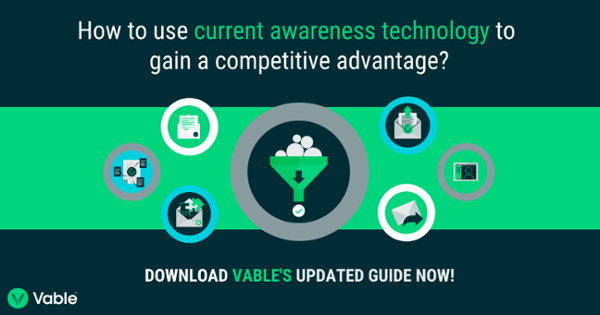Share this
How does competitive intelligence inform strategic decisions?
January 10, 2023

Compiling competitive intelligence is a standard requirement for law firm professionals. Library and information service and business development departments must collaborate and establish a partnership to provide intelligence of all kinds. We live in an age of information but to thrive in this environment we need targeted and actionable curated knowledge, otherwise, our firms will fail.
What is competitive intelligence and why is it important?
The Strategic & Competitive Intelligence Professionals (SCIP) define competitive intelligence as,
“A discipline that enables organizations to reduce strategic risk and increase revenue opportunities by having a deep understanding of what has happened, what is happening, and what may happen in their operating environment”.
Intelligence is essential for effective strategic planning:
- Strategic planning necessitates an awareness of the wider business environment. Everyone must be in the know when it comes to the broader issues that impact your organisation so that you can be as prepared as possible - global economic issues, changes in governments, policy development, regulatory change etc.
- Strategic planning necessitates an analysis of your competitors. Competitor or competitive analysis is the process of identifying competitors in your industry and researching their different marketing strategies. You can use this information as a point of comparison to identify your company's strengths and weaknesses relative to each competitor. This is where the library can step in and monitor competitors over time and detect patterns in order to predict future moves.
- Strategic planning necessitates an analysis of your organisation itself and how all these external factors might affect it. Are there new industries and practice areas that you can explore? How can you attract and keep talent? For instance, the way we work and how we are rewarded is constantly evolving and employees will respond to an innovative employer.
We understand the importance and purpose of competitive intelligence and how it affects our organisation. So where do we start?
Where does the knowledge/information service come in?
It's not just the knowledge departments that compile these types of research reports. We know that business development and client relation teams are involved too.
Whether it’s a basic snapshot or an in-depth analysis of the competitor landscape, it is something that we have all had to do. This is where you can employ your creative and out-of-the-box thinking and showcase your best work. After all, researchers are trained to consider everything. For example, non-commercial sources of information,
Jim Millar defined non-market intelligence as “the social, political, and legal arrangements that structure interactions among companies and their public. They provide an early warning of threats and opportunities emerging from the global public policy environment, and [provide an analysis of] how they will affect the achievement of a company’s strategy.”
The examples include the actions of government and legislative bodies, public interest groups and lobbyists, and all kinds of quasi-government agencies. All of these control and regulate businesses, regardless of the industry in which they operate. This presents organisations with both threats and opportunities.
Ultimately, people are short on time. Information must be well-packaged and delivered in bite-sized pieces. As discussed above, strategic decisions rely on quality information - there can be no FOMO and nothing must slip through the cracks. The problem we face is information overload; the more places you need to remember to search, the higher the risk of missing something.
The reports we create offer our organisations a perspective on changing market conditions so that management can identify risks and opportunities early enough to adapt or change strategy.
How can a premium content aggregator help?
A premium content aggregator enables you to search across fee/free information, as well as your own internal know-how. You are in full control of the content so you will always be receiving information from trustworthy reliable sources. Any source can be added, from legislation updates, premium subscriptions, opinion pieces and so on.
The right aggregator provides you and your team with options. Automating the majority of your alerts means that you are able to fully focus on adding value to other types of newsletters. Curated newsletters require specialist subject knowledge so that your end-users receive exactly what they need to do their job.
Subsequently, all end-users will find an accessible and digestible newsletter in their inbox, containing all the information they need - nothing more, nothing less. Reducing the barrage of information in this way increases the likelihood that end-users will retain and act upon the information they consume. This means more informed efficient strategic decisions for your organisation.
Insights don’t happen within a vacuum
Having the right current awareness and research resources is essential but that is just the beginning. Even before you start conducting your CI research, you need to set your objectives. During the reference interview, ask your end-user; What is it that we want to find out? What is the purpose of the research?
This will help you determine which avenues to pursue and what kind of data sources to mine. Is the end-user looking to:
- Enter new markets or practice areas
- Develop new products or services to drive client engagement
- Manage disruptive changes and increase innovation
- Draft a pitch to win new business
- Monitor a competitor after a service/product launch
Once a report has been completed and handed in, it might be where the library and information service contribution ends and they hand it over to the BD team for further refinement. But it is always worth checking with the end user whether they want to continue receiving updates on the matter because an important part of CI is the regular sharing of contextual and edited updates.
This is part of a chapter of our latest guide on how you can use current awareness technology to gain a competitive advantage. Download it now!
Share this
- April 2025 (1)
- March 2025 (1)
- October 2024 (1)
- July 2024 (1)
- June 2024 (2)
- May 2024 (2)
- April 2024 (3)
- March 2024 (3)
- February 2024 (4)
- January 2024 (2)
- December 2023 (1)
- November 2023 (2)
- October 2023 (2)
- September 2023 (1)
- August 2023 (3)
- July 2023 (5)
- June 2023 (2)
- May 2023 (2)
- April 2023 (4)
- March 2023 (1)
- February 2023 (1)
- January 2023 (2)
- November 2022 (2)
- September 2022 (2)
- August 2022 (2)
- July 2022 (1)
- June 2022 (1)
- May 2022 (2)
- April 2022 (3)
- March 2022 (1)
- February 2022 (2)
- December 2021 (2)
- November 2021 (2)
- October 2021 (2)
- September 2021 (2)
- August 2021 (2)
- July 2021 (2)
- June 2021 (2)
- May 2021 (1)
- April 2021 (2)
- March 2021 (1)
- February 2021 (3)
- January 2021 (2)
- November 2020 (3)
- October 2020 (1)
- August 2020 (2)
- July 2020 (4)
- June 2020 (1)
- May 2020 (1)
- April 2020 (2)
- March 2020 (2)
- February 2020 (3)
- January 2020 (1)
- December 2019 (2)
- November 2019 (1)
- October 2019 (1)
- September 2019 (1)
- August 2019 (3)
- July 2019 (3)
- June 2019 (3)
- May 2019 (2)
- April 2019 (1)
- March 2019 (2)
- February 2019 (3)
- January 2019 (3)
- December 2018 (1)
- November 2018 (2)
- October 2018 (2)
- September 2018 (1)
- August 2018 (2)
- July 2018 (1)
- June 2018 (2)
- May 2018 (3)
- April 2018 (3)
- March 2018 (1)
- February 2018 (3)
- January 2018 (1)
- November 2017 (1)
- October 2017 (1)
- July 2017 (1)
- April 2017 (2)
- March 2017 (3)
- February 2017 (1)
- January 2017 (1)
- November 2016 (2)
- October 2016 (1)
- September 2016 (1)
- August 2016 (2)
- June 2016 (1)
- May 2016 (1)
- April 2016 (1)

